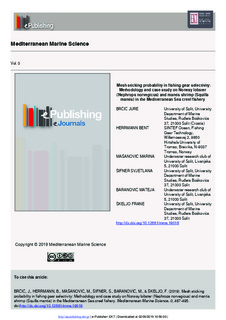| dc.contributor.author | Brcic, Jure | |
| dc.contributor.author | Herrmann, Bent | |
| dc.contributor.author | Masanovic, Marina | |
| dc.contributor.author | Krstulovic Sifner, Svjetlana | |
| dc.contributor.author | Baranovic, Mateja | |
| dc.contributor.author | Škeljo, Frane | |
| dc.date.accessioned | 2019-09-03T07:08:43Z | |
| dc.date.available | 2019-09-03T07:08:43Z | |
| dc.date.created | 2019-09-02T10:35:47Z | |
| dc.date.issued | 2019-08-27 | |
| dc.identifier.citation | Mediterranean Marine Science. 2019, 487-495. | nb_NO |
| dc.identifier.issn | 1108-393X | |
| dc.identifier.uri | http://hdl.handle.net/11250/2612128 | |
| dc.description.abstract | Fish or crustaceans stuck in the fishing gear meshes can lead to operational problems in some fisheries and thereby affect the economic gain. However, mesh sticking probability has never been formally quantified as a part of the estimation of fishing gir size selectivity. Therefore, this study developed a size selection model and estimation procedure that, besides the size dependent retention and escape probabilities, includes the size dependent mesh sticking probability. The new method was applied to quantify the size dependent retention, sticking and escape probabilities for mantis shrimp (Squilla mantis) and Norway lobster (Nephrops norvegicus) in creels with 41 mm square mesh netting. The mesh sticking probability was found to display a bell-shaped curvature with a maximum value for a specific carapace length and decreasing probabilities for both smaller and bigger individuals. For mantis shrimp the maximum sticking probability was found for 32.5 mm carapace length with a value at 13.5%, while 63.1% and 23.4% of that size were respectively retained inside the creels and escaped. For Norway lobster the maximum sticking probability was 2% and occurred for 34.0 mm carapace length. The method and estimation procedure presented in this study might be applicable for quantifying mesh sticking probability as an integral part of future fishing gear size selectivity studies on other species and fisheries. | nb_NO |
| dc.language.iso | eng | nb_NO |
| dc.rights | Navngivelse-Ikkekommersiell-DelPåSammeVilkår 4.0 Internasjonal | * |
| dc.rights.uri | http://creativecommons.org/licenses/by-nc-sa/4.0/deed.no | * |
| dc.subject | Sticking probability | nb_NO |
| dc.subject | selectivity | nb_NO |
| dc.subject | Norway lobster | nb_NO |
| dc.subject | mantis shrimp | nb_NO |
| dc.subject | creels | nb_NO |
| dc.title | Mesh sticking probability in fishing gear selectivity: Methodology and case study on Norway lobster (Nephrops norvegicus) and mantis shrimp (Squilla mantis) in the Mediterranean Sea creel fishery | nb_NO |
| dc.type | Journal article | nb_NO |
| dc.type | Peer reviewed | nb_NO |
| dc.description.version | publishedVersion | nb_NO |
| dc.rights.holder | Copyright © 2019 Mediterranean Marine Science | nb_NO |
| dc.source.pagenumber | 487-495 | nb_NO |
| dc.source.journal | Mediterranean Marine Science | nb_NO |
| dc.identifier.doi | 10.12681/mms.19018 | |
| dc.identifier.cristin | 1720482 | |
| cristin.unitcode | 7566,2,0,0 | |
| cristin.unitname | Sjømatteknologi | |
| cristin.ispublished | true | |
| cristin.fulltext | original | |
| cristin.qualitycode | 1 | |

